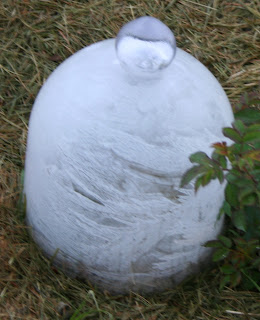.jpg) Twas the end times of summer and all through the beds,
Twas the end times of summer and all through the beds,Was a sighing of hope that the Dog Days had fled.
The garden was weeded and mulch was all down,
The rains filled the potholes and joy did abound.
Baby roses were nestled all snug and secured,
In milk jugs aplenty, their safety assured.
Mrs. ProfessorRoush in her afghan, and I with my shovel, preparing for winter to come to our hovel.
Well, I guess the poetry just falls apart at the mere mention of Mrs. ProfessorRoush.
What you are glimpsing in the picture to the right is the start of a new bed, with some baby Griffth Buck roses spaced out and covered by my usual milk-jug protectors. This is how I plant all rose bands these days, hard-won knowledge bought at the feet of many, many dead little roses. The milk jugs are my catchall protection equipment, providing increased humidity and some shade to the roses through the still-hot and sunny days here, and then later, as Fall wears on, giving them some protection from the cold nights and winds. I'll gradually cut these down a bit as the roses acclimate to provide them some extra sun and air movement, but I keep a tall collar in place to discourage rabbits and rodents from chewing these greenlings down to their base. As the temperatures approach freezing at night, I'll substitute glass cloches for the milk jugs to give them some extra protection against the worst of Winter.
I prefer Fall for planting these days, giving the plants time to develop good roots before Winter. The quick Kansas Springs give way too soon to Summer's heat, leaving spring-planted shrubs gasping for moisture and support. Planted here are Quietness, Queen Bee, Chorale, Gentle Persuasion, Prairie Clogger, Prairie Lass, September Song, Silver Shadows, Summer Wind, Paloma Blanca, Survivor, and, as usual for me, an unknown band. The unknown band is from my trial of a new rooting method this summer. I immediately forgot what variety I took the cuttings from and, of course, it rooted handily. Hopefully I can identify it in a few years when it reaches mature bloom. Or not.


